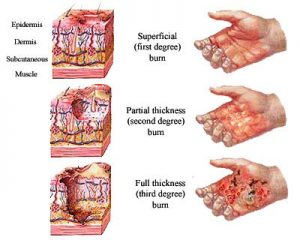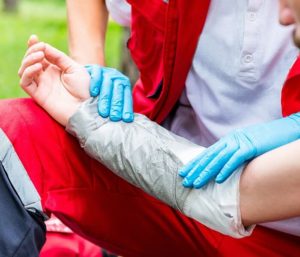What Are The Type Of Burns And their Treatments

- 1. Chemicals, wiring, and other substances that often play a role in severe burn events
- 2. Most medical resource materials refer to either three or four different burn degrees
- 3. Types of treatments often used or required when a patient presents with burn injuries
- 4. A brief list of possible burn injury complications – for both children and adults
Serious burn injuries can damage a patient’s surface skin layers, as well as the underlying muscles and bones. In most cases, the specific depth or degree of a burn determines how difficult it will be for the patient to fully heal. While some people develop severe burn injuries while employed on construction sites or in industrial business settings, others suffer devastating burns due to catastrophic motor vehicle accidents.
Before describing the different degrees of burn injuries below, it can prove helpful to also reference the substances – and highly specific events — often involved in burn accidents. This material ends with a look at common burn treatments and a few of the health complications that can develop while patients are trying to complete all recommended therapies.
Chemicals, wiring, and other substances that often play a role in severe burn events
- A workplace may have defective electrical wiring or circuits. When these are not properly turned off before new work tasks begin, employees can be easily harmed. Electrical burns, involving either AC or DC currents, can inflict severe burns to internal tissues that can be very hard to see or quickly detect.
- Hot gases, grease, water, and other liquids. Unfortunately, many highly flammable liquids are not properly labeled. And even when they are, employers often fail to provide sufficient personal protective equipment to workers who must use these substances. A scalding burn involving grease, oil, water, or tar can cause a deep skin burn in less than three seconds.
- Tanker trucks may often carry gasoline and other volatile substances on roads and highways. When these drivers have accidents, their crashes often prove fatal if the flammable loads catch on fire.
- Employees required to work with dangerous chemicals or liquids must be provided with proper respirators. They should also only be allowed to work in well-ventilated areas. Chemical burns are caused by alkali substances and strong acids. Until their active agent is deactivated, they will keep burning the skin and underlying tissues.
- Basic contact burns can also prove very painful. These usually involve plastics, glass, coals, or hot metals. Although “contact” burns to sound like minor injuries, they can develop deep beneath the skin and be very painful.
- Flash burns usually involve explosions of propane, natural gas, gasoline, or other types of flammable liquids. These burns can cause intense heat for very short time periods.
Most medical resource materials refer to either three or four different burn degrees
- Second-degree burns. Often referenced as “partial-thickness burns,” these involve damage to both a patient’s dermis and epidermis. The dermis is the second layer of skin beneath the top layer called the epidermis. These burns may feature blisters and are often very painful. They can also cause swelling in the burned area. Contact with boiling water can cause a second-degree burn in some cases. Patients with these burns may see their skin regrow — unless it has become highly infected. These burns usually heal within two to three weeks.
- Third-degree burns. These are extremely serious burns that require immediate emergency room care. They involve every skin layer and all the underlying skin tissues. Doctors often refer to these as “full-thickness” burns. Flames from a fire can cause third-degree burns – as well as a scalding liquid or chemical source. Surgery is nearly always required to keep these burns from creating serious scar tissue and skin contracture.
- A fourth-degree burn. This type of injury runs so deep that it usually involves all the patient’s muscles, ligaments, tendons, nerves, blood vessels, and bones. Immediate treatment must be obtained due to the extreme pain and to increase the patient’s chances of survival.
Everyone must remember that it is never wise to use cotton balls while trying to clean or dress a burn wound since the cotton fibers will stick to the burn areas.
Types of treatments often used or required when a patient presents with burn injuries
- Intravenous fluids will usually be introduced. They offer the proper electrolytes to help the patient fight off infections. These substances also help to maintain a proper body temperature – and keep all organs functioning properly.
- Special antibiotics will be injected into the patient’s body to help prevent infections. Burn creams and ointments will also be applied to the skin to minimize all pain and general discomfort. Under certain circumstances, especially if the person was on a construction site when burned, a new tetanus shot must be given.
- A pain management consultant will normally be called in for higher levels of burn injuries. Although no one should recommend the long-term use of painkillers due to addiction concerns, many burn patients may legitimately require these drugs during their early (and later) treatment stages.
- Surgical procedures and skin grafts. Doctors usually take skin from the healthiest parts of your body to help cover and close burn wound sites. Sadly, when human skin is burned too deeply, it cannot regenerate itself.
- Cosmetic reconstruction of burned areas. Many burn patients need this type of work done so they can heal properly. Skin discolorations and odd skin surfaces frequently require this type of treatment.
- Psychological and therapeutic services. Coming to terms with a greatly altered physical appearance can prove very depressing to most patients. A good therapist helps burn patients set realistic cosmetic goals for themselves — while also reminding them that they are already still fully deserving of love and kindness. Body image changes are difficult for all of us – and talking therapy can prove crucial to a patient’s overall recovery. As the body heals, so must a patient’s mind and heart.
The best treatment for burns is always carefully thought out — based on each patient’s needs.
A brief list of possible burn injury complications – for both children and adults
- Unlike most adults, children can develop seizures due to their burn injuries. When this occurs, your main doctor will likely consult with a pediatric neurologist.
- Respiratory problems. These tend to be the main cause of death for many burn patients who do not heal in a timely manner.
- Gastrointestinal ulcers. Unfortunately, these plague many patients who have suffered the deepest types of burn injuries.
If you have suffered serious burn injuries due to someone else’s negligence, you need to contact our New York City burn injury law firm. We will carefully investigate all the facts of your case, review all your medical records, and then fight hard to win the maximum compensation available to you. We want every client to fully recover for all lost wages, pain, and suffering, and other losses. While every effort is made to obtain a personal injury settlement, we always stand ready to file a burn injury lawsuit on your behalf and take it to court.






